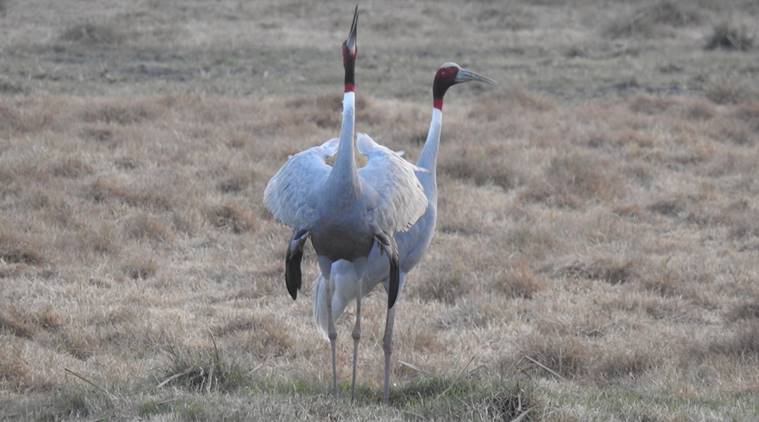- India
- International
In Gondia, youth give wings to Sarus conservation
The effort required the youth team to wade through slushy paddy fields for days, tracking the birds’ movement and protecting their surroundings.
 As word about the birds spread, people started thronging the nests, with some even clicking photos with the birds’ eggs in their hands. “That was a lesson for us — that Sarus conservation has to be a discreet affair,” Bahekar said.
As word about the birds spread, people started thronging the nests, with some even clicking photos with the birds’ eggs in their hands. “That was a lesson for us — that Sarus conservation has to be a discreet affair,” Bahekar said.
IN 2003-04, only four Sarus cranes (Grus antigone) were registered in Maharashtra, two each in Gondia and Chandrapur districts. Today, the state has over 35 of the birds, thanks to conservation steps by a group of youngsters from Gondia. The youth have earned praise for their efforts from the Forest Department as well as the International Crane Foundation.
Watch What Else Is Making News
While conservation initiatives in the state are generally aimed at the protection of terrestrial animals within the confines of a forest, Sustaining Environment and Wildlife Assemblage (SEVA), a wildlife NGO from Gondia, took it upon itself to save the tallest flying bird in the world, on the verge of decimation in the state. Today, the effort, started as a “people’s movement”, has extended to the neighbouring Balaghat district of Madhya Pradesh, which too has registered a population of 45 birds. “Gondia is home to Navegaon and Nagzira sanctuaries, where the forest department’s conservation efforts are concentrated on the tiger. In 2003-04, we came to know that only two Saras cranes were left in Gondia. That is when we decided to do something about it,” said Sawan Bahekar, president of SEVA and honorary wildlife warden of Gondia. “We started by taking care of the two birds and learning about their life and breeding cycles. We decided to protect their nests as a first step. Till 2006-07, we identified four nests at different places. Through sustained persuasion and awareness programmes, we managed to get several volunteers onboard for free. We also educated the public on how the Saras is actually a friend of agriculture, as it feeds on various pests and insects that affect the crop. It helps in the ‘khundal’ (pressing) process to help affix crop roots firmly inside the soil, to help it get more nutrients,” Bahekar said.
The effort required Bahekar’s team to wade through slushy paddy fields for days, tracking the birds’ movement and protecting their surroundings.
As word about the birds spread, people started thronging the nests, with some even clicking photos with the birds’ eggs in their hands. “That was a lesson for us — that Sarus conservation has to be a discreet affair,” Bahekar said.
The forest department provided help to the NGO. “Today, we have an army of 50-odd farmers and many volunteers. Varsha Patel, wife of former MP Praful Patel, has been very helpful too,” Bahekar said.

The best result of the effort was in 2011-12, when the number of nests went up to seven and the birds to 50. Today, it has come down to five nests and 35 birds. “We found that a pesticide called phoret was proving poisonous to the birds. We tell farmers not to use it, as it is banned anyway. But it is sold in the black market,” Bahekar claimed. In the Balaghat district, the number of nests has gone up to seven. Apart from adult birds, the region boasts of 16 fledglings.
Sarus expert from International Sarus Foundation Gopi Sundar, who visited Gondia twice, was all praise for Bahekar’s team. “The Saras population in Gondia is very important, since this is the southernmost part in India where the bird is found. Population loss at edges of the range leads to attrition of the overall range of species. Fortunately, efforts of Savan and his colleagues may see the stemming of this decline. Apart from monitoring, they are also preserving the bird’s habitat and moulding local farmers’ attitude. On behalf of International Crane Foundation, I am very proud to be supporting these efforts in Gondia,” Sundar said.
Behakar’s team has been organising a Sarus Festival at Gondia for the past two years to help increase awareness about the bird. “We reward volunteers and farmers for doing exemplary work,” said Bahekar, himself a winner of Youth Icon award given by a prominent newspaper group.
Rama Rao, who was Deputy Conservator of Forest, Gondia, before being transferred to Nashik as Chief Conservator of Forest, says, “The Gondia youth led by Behekar have done extraordinary work. They know the subject very well and have involved the general public into it to make it a people’s movement. So, we helped them in whatever they needed.”
Tallest bird
Considered the tallest flying bird in the world, a Sarus can grow up to six ft and weigh up to 10 kg. It has a wing span of about eight ft and lays two eggs. Always living in pairs, the birds take care of their nests that appear like a huge mound in the middle of paddy or wheat fields. The survival rate of the chicken is only up to 50 per cent. In India, it is found in Rajasthan, Uttar Pradesh, Gujarat and Madhya Pradesh. Two birds have also been located in Bhandara district of late.
Apr 25: Latest News
- 01
- 02
- 03
- 04
- 05







































